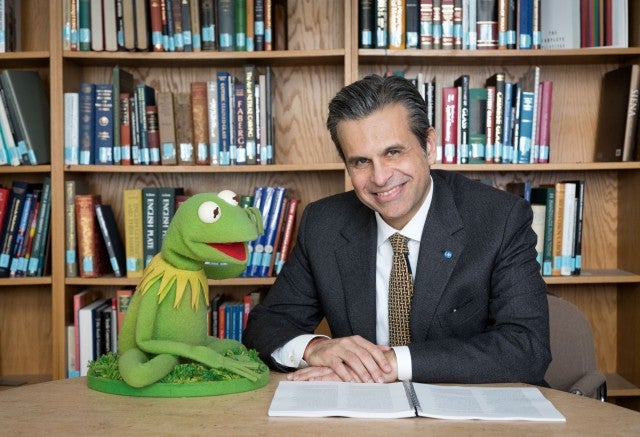From the Director, February 2020
Updated Jul 20, 2022
Kermit at the DIA
A couple of months ago, during our standing Tuesday Strategy Group meeting, where all the division heads gather to establish our chief lines of action, one of my colleagues announced that Kermit The Frog and Howdy Doody were going to go on display in our puppet case. I was familiar with the latter, but I had never heard the word Kermit in my life. So one of my colleagues pulled out her phone and showed me who Kermit was. Oh! I said, that is La Rana Gustavo (Kermit the Frog), which I knew very well growing up in Spain. It is amazing the influence Sesame Street has had globally, and I assume that in each country Kermit and the rest of the puppets had their names adapted to their local languages. In Spain, apart from Gustavo, we had Super Coco (Super Grover), El Monstruo de las Galletas (The Cookie Monster — my favorite) and El Conde Draco (Count von Count), among many others. I still remember learning how to count bats, with the sounds of thunder in the background, as the Count laughed on the black and white TV set. For a little boy, it felt scary but as you can see it was memorable and educational.
The influence of Kermit, like the rest of the puppets, goes beyond any race, class, and social background. All of them have touched each of us in many ways. When we announced that Kermit was going to be on view at the DIA, newspapers from all over the region and in many different communities published it. And for many, it was big news! I was mentioning all this to my wife Alex over breakfast, and I told her how in those years in Spain, I could only watch Sesame Street on Saturday mornings at 10 a.m. or so. There was only one TV channel and programming was just at certain hours. When we think about the number of channels we have today and that our TVs could go on 24/7, it seems that we had limited possibilities in the past. However, the memories of Kermit and the rest of the puppets on Saturday mornings at 10 a.m. bring back the feeling of how fortunate we were. We did not feel our possibilities were limited, and once the program was over, it was time to go and play with friends in the park. Times have changed, and while technology has improved our way of living, it has also brought some challenges.

Instead of being in front of those TV screens for too long, we would love for all the kids in our region to come to the DIA with their families on Saturday morning at 10 a.m. and see Gustavo (The real Kermit!) in the museum. While I knew that we had an extraordinary puppet collection, one of the best in the world, I was not aware that Kermit was part of it. This reminded me that when I became a curator here in 2008, I was also not aware that the DIA was the first civic museum in the U.S. to acquire a painting by Vincent Van Gogh, his famous self-portrait with a straw hat. From Kermit to Van Gogh, the DIA never ceases to amaze me, to give me opportunities to learn and to share unique moments with friends and family. We are leaders in education and provide first-hand experiences that can’t be found on TV or the internet. I think Kermit would agree— he liked art very much as one can tell from one of his famous and very creative dialogues with Gonzo:
Gonzo: Hey, Kermit, are you busy?
Kermit: Yes, Gonzo, but I can give you my ear for a minute
Gonzo: What would I do with your ear?
Kermit: [exasperated] Van Gogh impressions.

Salvador Salort-Pons portrait, updated Jan 2020
Kermit at the DIA
A couple of months ago, during our standing Tuesday Strategy Group meeting, where all the division heads gather to establish our chief lines of action, one of my colleagues announced that Kermit The Frog and Howdy Doody were going to go on display in our puppet case. I was familiar with the latter, but I had never heard the word Kermit in my life. So one of my colleagues pulled out her phone and showed me who Kermit was. Oh! I said, that is La Rana Gustavo (Kermit the Frog), which I knew very well growing up in Spain. It is amazing the influence Sesame Street has had globally, and I assume that in each country Kermit and the rest of the puppets had their names adapted to their local languages. In Spain, apart from Gustavo, we had Super Coco (Super Grover), El Monstruo de las Galletas (The Cookie Monster — my favorite) and El Conde Draco (Count von Count), among many others. I still remember learning how to count bats, with the sounds of thunder in the background, as the Count laughed on the black and white TV set. For a little boy, it felt scary but as you can see it was memorable and educational.
The influence of Kermit, like the rest of the puppets, goes beyond any race, class, and social background. All of them have touched each of us in many ways. When we announced that Kermit was going to be on view at the DIA, newspapers from all over the region and in many different communities published it. And for many, it was big news! I was mentioning all this to my wife Alex over breakfast, and I told her how in those years in Spain, I could only watch Sesame Street on Saturday mornings at 10 a.m. or so. There was only one TV channel and programming was just at certain hours. When we think about the number of channels we have today and that our TVs could go on 24/7, it seems that we had limited possibilities in the past. However, the memories of Kermit and the rest of the puppets on Saturday mornings at 10 a.m. bring back the feeling of how fortunate we were. We did not feel our possibilities were limited, and once the program was over, it was time to go and play with friends in the park. Times have changed, and while technology has improved our way of living, it has also brought some challenges.

Instead of being in front of those TV screens for too long, we would love for all the kids in our region to come to the DIA with their families on Saturday morning at 10 a.m. and see Gustavo (The real Kermit!) in the museum. While I knew that we had an extraordinary puppet collection, one of the best in the world, I was not aware that Kermit was part of it. This reminded me that when I became a curator here in 2008, I was also not aware that the DIA was the first civic museum in the U.S. to acquire a painting by Vincent Van Gogh, his famous self-portrait with a straw hat. From Kermit to Van Gogh, the DIA never ceases to amaze me, to give me opportunities to learn and to share unique moments with friends and family. We are leaders in education and provide first-hand experiences that can’t be found on TV or the internet. I think Kermit would agree— he liked art very much as one can tell from one of his famous and very creative dialogues with Gonzo:
Gonzo: Hey, Kermit, are you busy?
Kermit: Yes, Gonzo, but I can give you my ear for a minute
Gonzo: What would I do with your ear?
Kermit: [exasperated] Van Gogh impressions.

